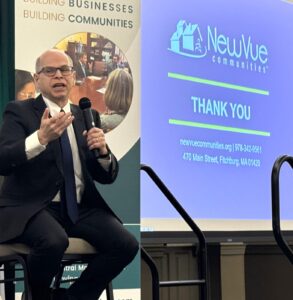The “Why” Behind the Fitchburg Arts Community

As NewVue Communities prepares to celebrate the opening of the highly anticipated Fitchburg Arts Community, Executive Director Marc Dohan recently shared why this project is so important to NewVue and the city of Fitchburg.
Speaking at the March Good Morning North Central breakfast series hosted by the North Central Massachusetts Chamber of Commerce, Marc explained how NewVue pursued the FAC to reignite civic pride in Fitchburg, and hopes that it will stand as a symbol of the city’s transformation.
“We built Fitchburg Arts Community because we believe in Fitchburg and North Central Massachusetts in general,” Marc said. “And we did it because we thought that this project was not just about an apartment, not just about a building, but it was about reimagining a neighborhood, a whole city.”
The FAC will do this by removing blight, bringing people downtown, restoring a neighborhood park, and celebrating the city’s past, he said.
Marc cited recent statistics showing that Worcester County has the third worst real estate market in the country for renters. For example, Leominster’s vacancy rate is 2.5 percent, the second tightest in the state among Gateway Cities. The Executive Office of Housing and Livable Communities estimates that Massachusetts needs to build over 200,000 new housing units by 2035 to keep pace with demand.
The need for housing is clear and even more in demand than when NewVue first envisioned the project 10 years ago. But why did NewVue focus on artist-preference housing?
“We built artist preference housing, because it builds on Fitchburg’s assets, and Fitchburg had many of the Hallmarks that makes the creative economy successful,” he said.
Those assets include the Fitchburg Art Museum, Fitchburg State University, and a diverse community. He said where some may see narrow, crowded streets in the city, NewVue saw walkabout streets. And where others may see old, vacant buildings like the former BF Brown School, Annex and City Stable, NewVue saw charming historic structures.
“We knew what would happen if we didn’t redevelop those three buildings,” Marc said. “They would rot and cast a pall over the neighborhood. We’ve all seen that movie before. We all know what vacant buildings do to neighborhoods.”
The next question became: Should NewVue take the easy route or hard one? Does the agency redevelop a school to create some new housing, paving the way for the city to demolish the other buildings for parking? Or does it help redevelop and revitalize an entire neighborhood?
“NewVue chose the hard route because it was a project that would engage a variety of stakeholders and partners from residents and politicians to historians, contractors and artists,” Marc said. As a non-profit community development corporation, NewVue can take some risks that a developer may not be willing to take. And perhaps most importantly, it was a transformative project that had an opportunity to help shape the future of the city.
“We kept hearing that Fitchburg had lost its pride,’’ Marc said. “We thought restoring three municipal buildings in a cutting-edge way that resonates with people was a great way for residents to feel proud and for Fitchburg to feel proud about itself.”
And as expected, the project has not been easy. In the 10 years since the project started, NewVue has:
- Seen a fire at BF Brown.
- Heard “no,’’ from lenders.
- Had to raise $1.5 million in private funding.
- Required an act of the Legislature
- Endured through a pandemic.
But during that time, the city has already experienced a number of positive changes. Marc said. He hopes this project builds on that momentum to create a brighter future for Fitchburg centered around the common vision of a creative economy.
“We want people living, shopping, lingering downtown,” he said. “We wanted to create a great destination.”